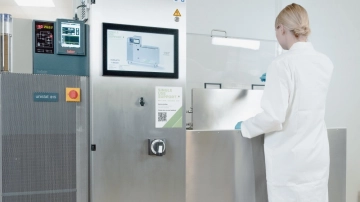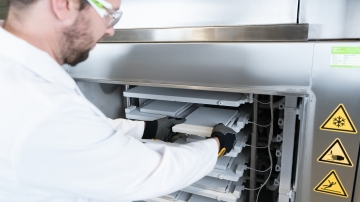How to maintain a cell bank?
Table of contents
ShowCell banking is a crucial process in biopharmaceutical production, ensuring the preservation and availability of valuable cell lines. Proper storage of cells and maintenance of a cell bank is essential to uphold the integrity and reproducibility of experimental results.
In this blog post, we will show best practices for maintaining a cell bank, from initial cell line characterization to cGMP compliance, storage, and troubleshooting tips.
Establishing a robust cell banking protocol
To maintain a reliable cell bank, it is crucial to establish a robust protocol right from the beginning. Here are some key practices to consider:
Initial cell line characterization
Accurate identification and authentication of cell lines are essential to ensure that the banked cells are true to their intended identity. Steps include implementing rigorous quality control measures to assess cell viability, morphology, and functionality. Followed by conducting genetic testing, such as STR (Short Tandem Repeat) analysis, to confirm the uniqueness and authenticity of the cell lines.1 2
Cryopreservation techniques
Cryopreservation is a critical step in maintaining cell viability and long-term storage. It is essential to optimize freezing and thawing protocols to minimize cell damage and maintain the cell line's functionality. There are common cryopreservation techniques which we will explore in the following.
Cryogenic freezing of cells with Single Use Support
Cryopreservation of cells requires high cell recovery rates and superior cell viability after thawing. Single Use Support pioneers freeze-thaw systems using their plate-based RoSS.pFTU for controlled freezing down to -80°C / -112°F and using their cryogenic freezer RoSS.LN2F based on controlled injections of liquid nitrogen enabling controlled cooling rates down to -170°C/-274°F. By utilizing controlled, cGMP-compliant, and scalable freezing techniques, reproducible processes and standardization are achieved.
State-of-the-art single-use technologies revolutionize fluid management and cold chain practices for cells. These solutions enable consistent cell counts, rapid aliquoting into smaller bioprocess containers and freezing processes in under an hour, while ensuring precise automated aseptic dispensing and controlled freezing.

Best practices for cell bank maintenance
Since cells and cell-derived products require distinctive storage conditions, manufacturers need to meet high standards in maintaining cell banks, irrespective of the individual cell bank type - master cell bank or working cell bank. Here are some best practices to consider:
Safe Storage of Cell Banks
Proper storage conditions are critical to maintaining cell line integrity and viability over time. Cell banks should be stored at appropriate temperatures, at least below -120°C, but typically below -150°C, using liquid nitrogen or ultra-low temperature freezers. Monitoring and controlling storage conditions, including temperature and humidity, is of utmost importance.3
Regular cell line authentication
Routine authentication of cell lines helps prevent cross-contamination and ensures the genetic stability of the cell lines. Regular STR analysis help to verify the genetic identity and uniqueness of the cell lines. Through comparison of the obtained STR profiles with the original cell line, any genetic changes or contamination are detected.4
Monitoring Cell Viability and Quality
Regular monitoring of cell viability and growth characteristics is essential to ensure the overall health of the cell lines. It is recommended to perform regular cell counting and viability assessments using appropriate methods, such as trypan blue exclusion or automated cell counters. With monitoring cell growth rates, morphology, and functionality, it is possible to detect any signs of cell line deterioration or contamination.5
Why not maintain a cell line in continuous culture?
While continuous culture of cell lines may offer some advantages, there are several disadvantages and risks associated with it. Here are a few reasons why maintaining a cell line in continuous culture may not be ideal:
- Genetic drift and phenotypic changes can occur over time, leading to inconsistencies and loss of characteristics.
- The risk of contamination and cross-contamination increases with prolonged continuous culture.
- The cost and time involved in continuously culturing cells can be significantly higher compared to maintaining a well-preserved cell bank.
In contrast, cell banking offers distinct advantages:
- Preserves cell line integrity and characteristics over time, minimizing genetic and phenotypic changes.
- Provides a reliable backup of cell lines, safeguarding against contamination or loss.
- Reduces costs and time associated with continuous culture by streamlining workflows and minimizing the need for frequent cell line isolation and characterization.
- By opting for cell banking, researchers and biopharmaceutical companies can overcome the challenges and risks associated with continuous cell culture.
Common Challenges in Cell Bank Maintenance
Maintaining a cell bank comes with its own set of challenges that researchers and biopharmaceutical companies may encounter. Some common issues include contamination, cell line misidentification, and low cell viability after thawing.
How Single Use Support addresses cell banking challenges
Single Use Support offers solutions for fast and safe handling of cells. Liquids are filled homogeneously into single-use bags, in a closed system and automated, therefore cGMP compliant. The subsequent freezing process can be precisely controlled to ensure the optimal freezing rate for the respective cell suspension. This helps to overcome challenges such as avoiding contamination and ensuring a high cell recovery rate - and subsequently provides the ideal conditions for long-term storage in a cell bank.
- , Published 1970-01-01
- Cell Banking best practices, https://www.wicell.org/home/resources/cell-banking-best-practices/cell-banking-best-practices.cmsx, Published
- Technical Considerations in the Freezing, Low-Temperature Storage and Thawing of Stem Cells for Cellular Therapies, http://dx.doi.org/10.1159/000497289, Published 2019-03-28
- The Importance of Cell-Line Authentication, https://www.biocompare.com/Editorial-Articles/579590-The-Importance-of-Cell-Line-Authentication/#:~:text=Cell%2Dline%20authentication%20is%20the,that%20they%20are%20contamination%2Dfree, Published 2021
- Trypan Blue Exclusion Test of Cell Viability, http://dx.doi.org/10.1002/0471142735.ima03bs111, Published 2015-11-02










